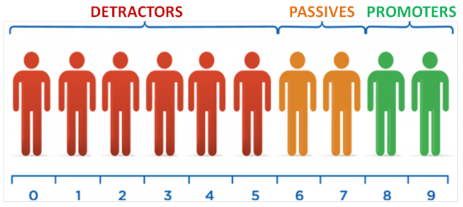|
"50 told me go head and switch the style up and if they hate, let 'em hate, watch the money pile up." Kanye West, Good Life About 3 years ago, the CEO of my company came over to me and said we should roll out NPS and asked me to lead the effort. I told him I had never heard of NPS. Probably not a great start. He gave me a brief overview of NPS - its promulgation by Bain & Company and the HBR article that unveiled NPS to the broader world (very good article to understand the correlation between company growth rates and NPS). I was then left to my own devices to figure out what to do next. What is NPS Before jumping into my journey with NPS, I want to give a brief overview of what it is. First, the only question you ask to determine NPS is: “How likely is it that you would recommend [company X] to a friend or colleague?” That's it. Then you let customers respond with an answer from 0 to 10. Promoters are anyone who gives you a 9 or 10. Neutral are 7s and 8s. Detractors are anyone from 0-6. Customers are often asked a follow up "What was the main reason for your score" but this is qualitative and does not factor into the score. To calculate the score: (Promotors - Detractors) / (Promotors + Neutrals + Detractors) * 100. That's it. Scores can range from +100 (all promoters) to -100 (all detractors). A positive score, above 0, is considered good, above 50 is excellent, and above 70 is world class. Why I thought NPS was absurd After spending 2 hours reading everything I could about NPS, my initial takeaway was that this was the single stupidest exercise I could be asked to do. I honestly didn't believe asking customers their likelihood to refer someone to my company would have any positive impact on what we were doing as a company (yes, despite the empirical evidence to the contrary). I just wasn't convinced. Rolling out NPS Despite my lack of enthusiasm for the project, getting the NPS pilot launched took almost no time. I gathered a few hundred e-mails from CRM, found a third party tool that focuses on NPS (we signed up for a free trial with AskNicely who we continue to use them today), uploaded the e-mail addresses and unique customer IDs, and then I hit send. Within 60 minutes we had over 100 responses (27% response rate). Better yet, over 50% of responses had a message about why the gave us that score. The messages were highlighting all the good stuff about our product/company (simple, fast, easy, great customer service) and also shining light on our shortcomings (reporting needs work, better visibility of payments, isn't great for bigger businesses). We also had our first NPS Score - 66 promoters, 19 neutrals, and 16 detractors = 49.5. I was excited that we had a pretty good NPS score and hungry to get more data. We started systematizing NPS within a few weeks and sending daily surveys to a random assortment of customers. I was totally wrong about NPS. Today we send hundreds of NPS surveys per day and aim to ask customers 1x a year for their opinion. We have consistently improved our NPS score and our Q2 2018 score 59. While we don't set a target to hit (say 70), we do try to improve quarter over quarter. Here is a snapshot of our NPS results since January 1st, 2016 (overall NPS of 56): How to use NPS - more than just a score I am by no means an expert on NPS but wanted to share the variety of ways (and growing) of how NPS can significantly improve your business:
Takeaways and Further reading I hope that if you aren't using NPS at your company my tale can convince you that you should start. If you have more than 100 customer and aren't using NPS - you are shortchanging your opportunity for growth. Resources I would recommend - The Ultimate Question (the NPS bible) as well as Net Promoter Score: Implement the System. Comments are closed.
|



